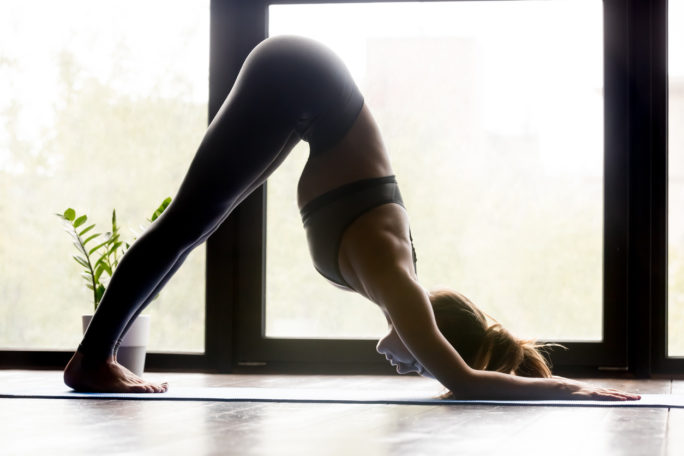“Downward Facing Dog is an inversion pose,” explains our resident yogini Trudy Vains. “Any time your head is below your heart you are inverted. You will feel so good throughout and after this pose, with the added benefit of stretching every part of your body.
“Many people strive to ‘look perfect’ in this pose, but ideally, we should be thinking about what it ‘feels’ like to be in this pose and ‘why’ we need do it.
“Downward Facing Dog is a good grounding and stabilising pose, so take advantage of that and breathe in and out through the nose, nice and slowly.
“From a practical physical sense, let’s look at this pose from two different perspectives. There is the traditional Downward Facing Dog, and a slight adjustment for those who may have sore wrists or other such injuries – Dolphin Pose.”
Traditional Downward Facing Dog
- Stand with feet flat, slightly apart, hands by your side.
- Breathe in deeply as you raise hands above your head and draw your core in as though you are bringing your belly button towards your spine.
- Bend to press palms firmly down on the floor and slide feet backwards to create the V shape as in the picture.
- Tuck your toes, raising heels high in the air.
- Lift your bottom up towards the ceiling, and then press your bottom backwards as though you were trying to bump the wall behind you. Try to flatten feet to floor. Don’t worry if you can’t get all the way – the more you do the pose, the more flexible you will become.
- Think of your body as being in the shape of an upside down V.
- If you notice your spine isn’t straight, or find it difficult, slightly bend your knees and send your bottom backwards more.
- Close your eyes and go totally within. Feel the pose, breathe, what can you feel within you? Hold for 10 seconds if you can. What is your body telling you?
Dolphin Pose
“Sore wrists? No problem. You can do the same pose but on forearms instead – it’s called Dolphin Pose,” says Trudy.
- Come to hands and knees position.
- Bring your elbows and forearms to the floor.
- Place forearms on the floor, palms facing down.
- Engage your core – belly button to spine.
- Tuck your toes, raising heels high in the air.
- Lift your bottom up towards the ceiling and press your bottom backwards, keep a slight bend in your knees. Try to flatten feet to floor.
- Try to keep arms and ears in alignment, and slightly bring chin to chest.
- To come out of the pose, make sure that your core is engaged, bring knees to the floor, and tops of the feet, then slightly lift your head and look towards the front of your mat.
Benefits
- It’s a full body stretch! It stretches your hamstrings, calves, arches, and hands.
- It strengthens and stretches your arms, shoulders, and back.
- It improves mobility of your digestive system.
- It relieves back pain, headaches, insomnia, and fatigue.
- It boosts your mood and helps you see the world from a different perspective.
Happy stretching.

